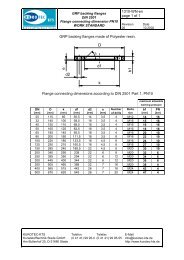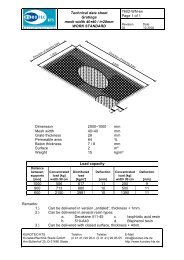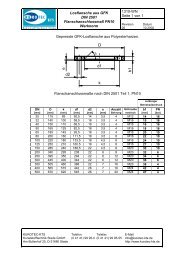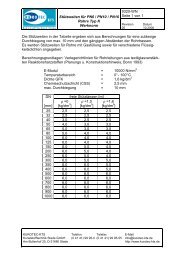Composite polymers - Kurotec-kts.de
Composite polymers - Kurotec-kts.de
Composite polymers - Kurotec-kts.de
Create successful ePaper yourself
Turn your PDF publications into a flip-book with our unique Google optimized e-Paper software.
COMPOSITE POLYMERS<br />
6<br />
CHEMICAL RESISTANCE GUIDE<br />
FOOTNOTES<br />
Information indicated in footnotes is essential<br />
in or<strong>de</strong>r to ensure a good service life of FRP<br />
equipment. It is strongly recommen<strong>de</strong>d that<br />
they are followed.<br />
1. Double synthetic veil should be used in<br />
the CR barrier.<br />
2. Postcure recommen<strong>de</strong>d to maximize<br />
service life.<br />
3. Benzoyl Peroxi<strong>de</strong>/Amine cure system<br />
with postcure recommen<strong>de</strong>d to increase<br />
service life.<br />
4. Recommen<strong>de</strong>d provi<strong>de</strong>d that solvent used<br />
for dissolution is also recommen<strong>de</strong>d.<br />
5. Satisfactory up to maximum stable<br />
temperature for product.<br />
6. Check with corrosion technical service<br />
lab for specific recommendations.<br />
7. Probably satisfactory at higher temperatures,<br />
but temperature shown is the highest for<br />
which information was available.<br />
8. Double surfacing veil and a 5 mm/200<br />
mil CR barrier should be used.<br />
9. Double C-veil should be used in the<br />
CR barrier.<br />
10. For reactors, use 441, 411 or 510A/C resins.<br />
11. Within the solubility limits in aqueous<br />
solution.<br />
12. Above 50°C/120°F, acid resistant glass should<br />
be used in the CR barrier and may be used in<br />
the structural wall.<br />
13. Acid resistant glass should be used in the<br />
corrosion liner and may be used in the<br />
structural wall.<br />
14. Chemical composition is unknown, obtain<br />
Safety Data Sheet from supplier.<br />
15. Slight discoloration of high purity acid can<br />
occur during first exposures.<br />
16. The use of the resin above the maximum<br />
allowable <strong>de</strong>sign temperature as limited by<br />
national <strong>de</strong>sign standards may require<br />
approval of the relevant authorities.<br />
NR: Not Recommen<strong>de</strong>d<br />
LS: Limited service, in general 3 days to<br />
1 year lifetime at room temperature (max.<br />
40°C/100°F), usually sufficient for secondary<br />
containment.<br />
POSTCURE<br />
For a service temperature below 100°C/210°F:<br />
A postcure may extend the service life if the operating<br />
temperature is within 20°C/40°F of the<br />
present CR gui<strong>de</strong> maximum temperature for the<br />
service. This means that a postcure can be beneficial<br />
for solvent applications with a temperature<br />
limit of 25-40°C/80-100°F.<br />
For a service temperature above 100°C/210°F:<br />
Postcure in service may be sufficient, provi<strong>de</strong>d the<br />
resin specific minimum Barcol hardness values are<br />
reached before start up.<br />
For service in pure and neutral salt solutions:<br />
Postcure may, in general, not be required,<br />
provi<strong>de</strong>d the resin specific minimum Barcol<br />
hardness values are reached and no acetone<br />
sensibility is shown before start up.<br />
When using a BPO/Amine cure system, postcure<br />
is strongly recommen<strong>de</strong>d and should be done<br />
within two weeks of construction.<br />
The postcure conditions as <strong>de</strong>tailed in DIN<br />
18820 may be used:<br />
• For 411, 441, 510A/C and 8084 resins:<br />
80°C/180°F.<br />
• For 470 and 510N resins: 100°C/210°F.<br />
• This norm recommends 1 hour per mm<br />
thickness of the laminate (between 5 and<br />
15 hours).









